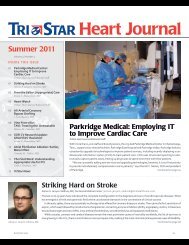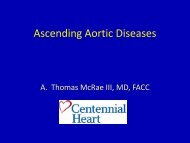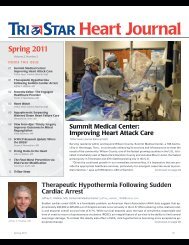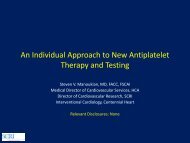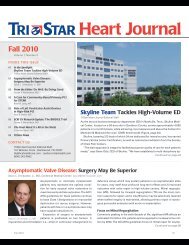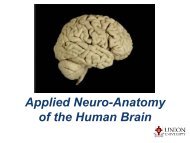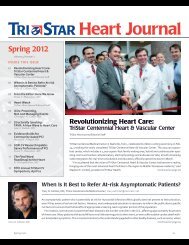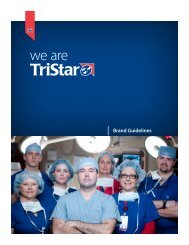TAVR is Here! - TriStar Health
TAVR is Here! - TriStar Health
TAVR is Here! - TriStar Health
Create successful ePaper yourself
Turn your PDF publications into a flip-book with our unique Google optimized e-Paper software.
Current Status of Percutaneous<br />
Aortic Valve Replacement: <strong>TAVR</strong> <strong>is</strong><br />
<strong>Here</strong>!<br />
John A Riddick<br />
Centennial Heart
What <strong>is</strong> <strong>TAVR</strong>?<br />
• Transcatheter Aortic Valve Replacement<br />
• TAVI - Implantation<br />
• Percutaneous AVR or Perc AVR<br />
• Approaches:<br />
– Femoral<br />
– Transapical<br />
– Transaortic<br />
– Subclavian
Who gets a <strong>TAVR</strong><br />
• Severe , symptomatic aortic stenos<strong>is</strong><br />
• Inoperable – The U.S. became the 43 rd country<br />
to have commercially available <strong>TAVR</strong> when the<br />
FDA approved Edwards SAPIEN Balloon<br />
Expandable valve on November 2 nd , 2011<br />
• CMS/Medicare evaluating <strong>TAVR</strong> currently for a<br />
NCD to determine insurance coverage
How do we get a Valve in through the<br />
leg?
The Partner Trial – Cohort B<br />
September 22, 2010 on NEJM.org
Objectives<br />
• To evaluate the clinical outcomes of the<br />
Edwards SAPIEN transcatheter heart valve<br />
(THV) compared to standard therapy at 2<br />
years in “inoperable” patients with severe<br />
symptomatic native aortic valve stenos<strong>is</strong><br />
• To assess valve hemodynamic performance<br />
using echocardiography<br />
• To perform analyses to better define the<br />
impact of comorbidities on outcomes<br />
7
Aortic Stenos<strong>is</strong>
Aortic Stenos<strong>is</strong> Is Life-Threatening and<br />
Progresses Rapidly 1<br />
• Survival after onset of symptoms <strong>is</strong> 50% at 2 years and 20% at 5 years 2<br />
• Surgical intervention for severe aortic stenos<strong>is</strong> should be performed promptly once<br />
even minor symptoms occur 2
Undertreatment Is Profound
A New Era Begins<br />
• There has been tremendous interest in<br />
transcatheter aortic valve replacement (<strong>TAVR</strong>)<br />
since the first procedure in 2002<br />
• Since then, patient selection, operator skills,<br />
and technology have improved<br />
• There was a requirement for clinical data to<br />
evaluate <strong>TAVR</strong> compared with current<br />
standard therapies
TA, transapical; TF, transfemoral.<br />
Rigorous Study Design
Rigorous Study Protocols
Strict Site Selection<br />
St. Paul's Hospital<br />
Vancouver, Canada<br />
Univ. of Washington<br />
Seattle, WA<br />
Hospital Laval<br />
Quebec City,<br />
Canada<br />
Stanford<br />
University<br />
Stanford, CA<br />
Cedars-Sinai Medical Center<br />
Los Angeles, CA<br />
Scripps Clinic<br />
La Jolla, CA<br />
Mayo Clinic<br />
Rochester, MN<br />
Northwestern Univ.<br />
Chicago, IL<br />
Barnes-Jew<strong>is</strong>h Hospital<br />
St. Lou<strong>is</strong>, MO<br />
St. Luke’s Hospital<br />
Kansas City, MO<br />
Evanston Hospital<br />
Chicago, IL<br />
Cleveland Clinic<br />
Cleveland, OH<br />
Toronto Gen.<br />
Hospital<br />
Toronto, Canada<br />
Univ. of Penn<br />
Phila., PA<br />
Washington<br />
Hosp. Center<br />
Wash., DC<br />
Mass. General<br />
Boston, MA<br />
Columbia University<br />
New York, NY<br />
Medical<br />
City Dallas<br />
Dallas, TX<br />
Emory University<br />
Atlanta, GA<br />
Leipzig Heart Center<br />
Leipzig, Germany<br />
n = 358 Cohort B patients<br />
22 Cohort B investigator sites<br />
18 USA, 3 Canada, 1 Germany<br />
Univ. of Miami<br />
Miami, FL
The PARTNER Trial Cohort B<br />
Study Devices<br />
Edwards SAPIEN Transcatheter<br />
Heart Valve<br />
RetroFlex 3<br />
Introducer Sheath Set<br />
RetroFlex 3<br />
Delivery System<br />
Crimper<br />
RetroFlex<br />
Balloon Catheter<br />
RetroFlex Dilator Kit<br />
Atrion<br />
Inflation Devices
Stringent Patient Screening<br />
Screening Methodology<br />
• Screening including clinical evaluation, echocardiography<br />
(+ TEE as needed), full catheterization and angiography<br />
(including coronaries), and vascular access assessment<br />
• Case screening logs<br />
(screen failure rate > 70% at most sites)<br />
• Case review webcast presentations<br />
(twice per week when necessary for expedited reviews)<br />
for cohort assignment and treatment strategy d<strong>is</strong>cussions<br />
(every patient enrolled)<br />
• Treatment goal: within 2 weeks of randomization
Careful Patient Selection<br />
• Select inclusion criteria<br />
• Severe symptomatic native aortic valve stenos<strong>is</strong> (aortic valve area < 0.8<br />
cm 2 , mean gradient > 40 mm Hg, or peak aortic jet velocity > 4.0 m/s)<br />
• Predicted r<strong>is</strong>k of mortality or irreversible morbidity > 50% as determined<br />
by 2 cardiothoracic surgeons and a cardiolog<strong>is</strong>t<br />
• Select exclusion criteria<br />
• Left ventricular ejection fraction (LVEF) < 20%<br />
• Severe (> 3+) mitral regurgitation (MR) or aortic regurgitation (AR)<br />
• Untreated coronary d<strong>is</strong>ease (CAD) requiring revascularization<br />
• Serum creatinine > 3.0 mg/dL or hemodialys<strong>is</strong><br />
• Recent myocardial infarction (1 month), stroke, or transient <strong>is</strong>chemic<br />
attack (6 months)<br />
• Life expectancy < 12 months
An Elderly and Highly Symptomatic<br />
Population<br />
.
25% of Patients Had an STS Score ≥ 15 and 37% of<br />
Patients Had an STS Score < 10
Patients Had Multiple Severe<br />
Comorbidities
Key Insights for Cohort B<br />
• Standard therapy <strong>is</strong> failing these patients with<br />
severe symptomatic native aortic valve<br />
stenos<strong>is</strong><br />
– <strong>TAVR</strong> with Edwards SAPIEN THV delivers:<br />
• Superior survival rate<br />
• Reduction in symptoms and restoration of quality of life<br />
• Improvement in hemodynamics<br />
• Sustained valve performance
Standard Therapy Is Failing These<br />
Patients<br />
Standard therapy, including balloon aortic<br />
valvuloplasty (BAV), did not alter the d<strong>is</strong>mal<br />
natural h<strong>is</strong>tory of patients with severe<br />
symptomatic native aortic valve stenos<strong>is</strong><br />
• All-cause and cardiovascular mortality at 2<br />
years were 68.0% and 62.4%, respectively
Absolute Reduction in Mortality<br />
Continues to Diverge at 2 Years
30% Absolute Reduction in<br />
Cardiovascular Mortality
35% Reduction in Repeat<br />
Hospitalization
Error bars = ± 1 Std Dev<br />
Reduced Mean Gradient
Error bars = ± 1 Std Dev<br />
Increased Valve Area
Significant Improvement<br />
in 6-Minute Walk Test
KCCQ Subscales
Higher Incidence of Stroke<br />
30
Mortality or Stroke<br />
31
Higher Incidence of Major Vascular<br />
Complications<br />
32
Higher Incidence of Major Bleeding<br />
* Major bleeding <strong>is</strong> defined as an event that causes death; causes a hospitalization or prolongs hospitalization; requires pericardiocentes<strong>is</strong> or an open and/or endovascular<br />
procedure for repair or hemostas<strong>is</strong>; causes permanent d<strong>is</strong>ability (eg, blindness, paralys<strong>is</strong>, hearing loss); or requires transfusion of > 3 units of blood within a 24-hour period.
New Pacemaker Implantation
Paravalvular Regurgitation<br />
Slightly Improved Over Time
Conclusions<br />
At 2 years, in patients with severe symptomatic native aortic<br />
valve stenos<strong>is</strong> who were not suitable candidates for surgery:<br />
• Treatment with the Edwards SAPIEN THV remained superior<br />
to standard therapy with incremental benefit from 1 to 2<br />
years, reducing the rates of mortality and repeat<br />
hospitalization<br />
• Treatment with the Edwards SAPIEN THV improved NYHA<br />
functional status and decreased class III/IV symptoms<br />
compared to standard therapy
Conclusions<br />
• There were significantly more strokes in patients<br />
treated with the Edwards SAPIEN THV than in<br />
patients who received standard therapy<br />
• After 30 days, differences in stroke frequency were largely<br />
due to increased hemorrhagic strokes in patients treated<br />
with the Edwards SAPIEN THV<br />
• Patients treated with the Edwards SAPIEN THV<br />
also had a higher incidence of major vascular<br />
complications and major bleeding than standard<br />
therapy patients
Clinical Implications<br />
• Two-year data continue to support the role of<br />
treatment with the Edwards SAPIEN THV as the<br />
standard of care for patients with severe<br />
symptomatic native aortic valve stenos<strong>is</strong> who are<br />
not surgical candidates<br />
• The ultimate value of the Edwards SAPIEN<br />
THV in “inoperable” patients will depend on<br />
careful selection of patients who are not surgical<br />
candidates, and yet do not have extreme<br />
comorbidities that overwhelm the benefits and<br />
render the intervention futile
March 26 th 2012
What’s next<br />
• High R<strong>is</strong>k surgical patients (operative<br />
candidates) – FDA likely begin approval<br />
process th<strong>is</strong> summer<br />
• Core Valve self-expanding percutaneous AVR<br />
(CoreValve U.S. Pivotal Trial)<br />
• 18 F Edwards Sapient XT Valve (Partner II trial -<br />
US)<br />
• 16 F Edwards eSheath expandable system<br />
(European studies)
<strong>TAVR</strong>: A novel, hybrid approach
One Call…<br />
855-900-VALVE



